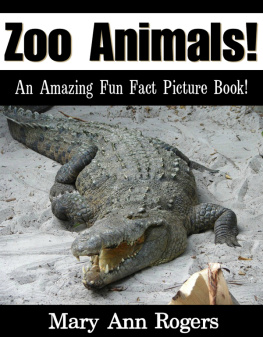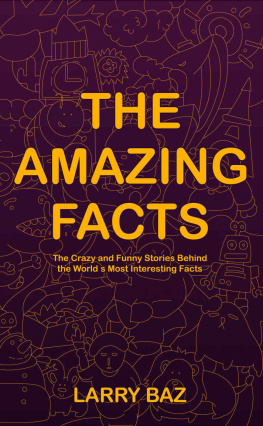Table of Contents
WHALES Amazing Pictures & Fun Facts on Animals in Nature Our Amazing World Series Kay de Silva
Copyright Notice Whales - Our Amazing World Series Copyright 2012 by Kay de Silva - All rights reserved Please respect the author's copyright of this work. You may use this e-book for your personal enjoyment. Like a printed book you may share it with family and friends. In so doing please do not change the format or modify the content in any way. In addition, your license to enjoy this work does not extend to re-selling, using or re-distributing this work wholly or partially for any other commercial endeavour. In all other respects, as a licensed owner of this e-book you are invited to enjoy and benefit from this work.
Please support the author, by spreading the word about this work to those who could benefit by it and encouraging them to obtain a personal license to enjoy the book. Image Credits: Royalty Free images reproduced under licence from various stock image repositories. Images produced under a creative commons licences are duly attributed. Books in the Our Amazing World Series Marine Life Four-Pack Horses Dolphins Sea Turtles Whales Penguins Marsupials Tigers Dinosaurs Sharks Snakes Spiders Bears Whales  Whales are big animals that live in the oceans. Whales are mammals , not fish. Whales are even bigger than dinosaurs.
Whales are big animals that live in the oceans. Whales are mammals , not fish. Whales are even bigger than dinosaurs.
Anatomy  Blue Whales are known as the largest animals to have ever lived on earth. They can be 100 feet (30.5 meters) long and weigh 100 tons (101.6 tonnes). This equals the weight of about 23 elephants. Their tongues alone weigh as much as an elephant. Migration
Blue Whales are known as the largest animals to have ever lived on earth. They can be 100 feet (30.5 meters) long and weigh 100 tons (101.6 tonnes). This equals the weight of about 23 elephants. Their tongues alone weigh as much as an elephant. Migration  Whales live in oceans around the world. During winter, whales go from cold to warmer parts of the ocean.
Whales live in oceans around the world. During winter, whales go from cold to warmer parts of the ocean.
They have a thick layer of fat under their skins. The fat is called blubber and helps them to keep warm. Breathing  Whales breathe air. They do not have gills like fish. They come up to the top of the ocean to get air. They use a blowhole found on the top of their heads to draw air in.
Whales breathe air. They do not have gills like fish. They come up to the top of the ocean to get air. They use a blowhole found on the top of their heads to draw air in.
Whales cannot sleep for more than 90 minutes at a time because they need to come up for air. Toothed Whales  Some whales have teeth. Others have baleen. Toothed Whales feed on small fish such as salmon, tuna, cod, and small mammals. Orca Whales, also known as Killer Whales , are Toothed Whales. They are known as the Wolves of the Sea.
Some whales have teeth. Others have baleen. Toothed Whales feed on small fish such as salmon, tuna, cod, and small mammals. Orca Whales, also known as Killer Whales , are Toothed Whales. They are known as the Wolves of the Sea.
They eat fish, dolphins, seals, and even Blue Whales. Baleen Whales  Baleen Whales have a row of plates on their upper jaws. The baleen looks like the teeth of a comb. Baleen Whales feed on plankton (a sea plant) and krill (a small, shrimp-like creature). Baleen Whales are much larger than Toothed Whales. They have 2 blowholes instead of one.
Baleen Whales have a row of plates on their upper jaws. The baleen looks like the teeth of a comb. Baleen Whales feed on plankton (a sea plant) and krill (a small, shrimp-like creature). Baleen Whales are much larger than Toothed Whales. They have 2 blowholes instead of one.
Whale Song  Whales are noisy animals. They are the loudest animals in the world. They sigh, moan, groan, and speak to each other. These sounds travel very far across the ocean. Whale Families
Whales are noisy animals. They are the loudest animals in the world. They sigh, moan, groan, and speak to each other. These sounds travel very far across the ocean. Whale Families  Whales live in large groups called herds. Mother whales are called cows.
Whales live in large groups called herds. Mother whales are called cows.
Father whales are called bulls. Baby whales are called calves. A whale calf grows inside its mother before it is born. Baby Whales  Whale calves drink their mother's milk. The milk is full of fat and is as thick as toothpaste. The mother squirts the milk into the calf's mouth.
Whale calves drink their mother's milk. The milk is full of fat and is as thick as toothpaste. The mother squirts the milk into the calf's mouth.
Play  Whales are playful animals. They can swim very fast. They also love to leap through the water into the air. This is called breaching. Blue Whales
Whales are playful animals. They can swim very fast. They also love to leap through the water into the air. This is called breaching. Blue Whales  Blue Whales are the largest animals in the world. They get their name from their bluish-grey skin color.
Blue Whales are the largest animals in the world. They get their name from their bluish-grey skin color.
Blue Whales eat mostly krill. During the feeding season one Blue Whale captures about 40 million krill every day. Baby Blue Whales drink about 50 gallons of their mother's milk. Blue Whales off the coast of Sri Lanka are known to make songs of four notes. These songs last about 2 minutes each. Beluga Whales  Beluga Whales are dark grey when they are born.
Beluga Whales are dark grey when they are born.
Their color fades over time. They are snow white as adults. Beluga Whales look gentle, but do not let their smiles fool you. These Toothed Whales are carnivores, which means they eat other animals. They will eat any sea creature that is smaller than themselves. Fin Whales  Fin Whales are the second largest animal after the Blue Whale.
Fin Whales are the second largest animal after the Blue Whale.
They grow to nearly 88 feet (27 meters) long. They have slender bodies. They are called the Greyhounds of the Sea , because of their slim build and high speed when hunting. Fin Whales can get 20 pounds (9 kilograms) of krill in a single gulp. They can gulp as often as every 30 seconds. Grey Whales  Grey Whales are medium-sized and grow to as large as 45 feet (13 meters) long.
Grey Whales are medium-sized and grow to as large as 45 feet (13 meters) long.
They are grey with white patches of parasites (barnacles and lice). They feed differently from other whales. These whales stir up shallow coastal areas and suck up small animals from the bottom. Grey Whales have one of the longest migrations of all mammals. They live in the Arctic during the summer and travel to California as it gets cold. Humpback Whales  Humpback Whales feed in groups.
Humpback Whales feed in groups.
This is known as lunge feeding or bubble-net feeding. The whales work as a team to catch large schools of herring (a type of fish). Each team member has a job. Some blow bubbles around the fish to stop them from escaping. Others vocalize to scare the fish and bring them to the top. Others herd the fish.
Then the whales open their mouths wide and gulp as many fish as they can. Minke Whales 








 Whales are big animals that live in the oceans. Whales are mammals , not fish. Whales are even bigger than dinosaurs.
Whales are big animals that live in the oceans. Whales are mammals , not fish. Whales are even bigger than dinosaurs. Blue Whales are known as the largest animals to have ever lived on earth. They can be 100 feet (30.5 meters) long and weigh 100 tons (101.6 tonnes). This equals the weight of about 23 elephants. Their tongues alone weigh as much as an elephant. Migration
Blue Whales are known as the largest animals to have ever lived on earth. They can be 100 feet (30.5 meters) long and weigh 100 tons (101.6 tonnes). This equals the weight of about 23 elephants. Their tongues alone weigh as much as an elephant. Migration  Whales live in oceans around the world. During winter, whales go from cold to warmer parts of the ocean.
Whales live in oceans around the world. During winter, whales go from cold to warmer parts of the ocean. Whales breathe air. They do not have gills like fish. They come up to the top of the ocean to get air. They use a blowhole found on the top of their heads to draw air in.
Whales breathe air. They do not have gills like fish. They come up to the top of the ocean to get air. They use a blowhole found on the top of their heads to draw air in. Some whales have teeth. Others have baleen. Toothed Whales feed on small fish such as salmon, tuna, cod, and small mammals. Orca Whales, also known as Killer Whales , are Toothed Whales. They are known as the Wolves of the Sea.
Some whales have teeth. Others have baleen. Toothed Whales feed on small fish such as salmon, tuna, cod, and small mammals. Orca Whales, also known as Killer Whales , are Toothed Whales. They are known as the Wolves of the Sea. Baleen Whales have a row of plates on their upper jaws. The baleen looks like the teeth of a comb. Baleen Whales feed on plankton (a sea plant) and krill (a small, shrimp-like creature). Baleen Whales are much larger than Toothed Whales. They have 2 blowholes instead of one.
Baleen Whales have a row of plates on their upper jaws. The baleen looks like the teeth of a comb. Baleen Whales feed on plankton (a sea plant) and krill (a small, shrimp-like creature). Baleen Whales are much larger than Toothed Whales. They have 2 blowholes instead of one. Whales are noisy animals. They are the loudest animals in the world. They sigh, moan, groan, and speak to each other. These sounds travel very far across the ocean. Whale Families
Whales are noisy animals. They are the loudest animals in the world. They sigh, moan, groan, and speak to each other. These sounds travel very far across the ocean. Whale Families  Whales live in large groups called herds. Mother whales are called cows.
Whales live in large groups called herds. Mother whales are called cows. Whale calves drink their mother's milk. The milk is full of fat and is as thick as toothpaste. The mother squirts the milk into the calf's mouth.
Whale calves drink their mother's milk. The milk is full of fat and is as thick as toothpaste. The mother squirts the milk into the calf's mouth. Whales are playful animals. They can swim very fast. They also love to leap through the water into the air. This is called breaching. Blue Whales
Whales are playful animals. They can swim very fast. They also love to leap through the water into the air. This is called breaching. Blue Whales  Blue Whales are the largest animals in the world. They get their name from their bluish-grey skin color.
Blue Whales are the largest animals in the world. They get their name from their bluish-grey skin color. Beluga Whales are dark grey when they are born.
Beluga Whales are dark grey when they are born. Fin Whales are the second largest animal after the Blue Whale.
Fin Whales are the second largest animal after the Blue Whale. Grey Whales are medium-sized and grow to as large as 45 feet (13 meters) long.
Grey Whales are medium-sized and grow to as large as 45 feet (13 meters) long. Humpback Whales feed in groups.
Humpback Whales feed in groups.